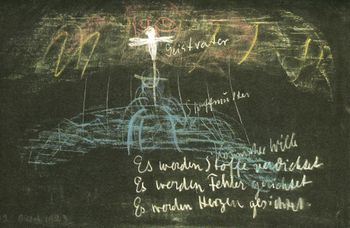St. John Imagination

The St. John Imagination, as given by Rudolf Steiner, describes how around St. John's Day on June 24, when the spiritual-soul is most strongly exhaled, the imaginative picture of Uriel is formed out of the cosmos, who looks down into the depths of the Earth with a serious, judging gaze, where he can read the errors and aberrations of humanity. (Lit.:GA 229, p. 63ff)
At the height of summer, the spiritual-soul of the Earth - in the hemisphere where it is summer - is at its most exhaled. The elementary beings dance in the air and their round dance is a living picture of the cosmic forces that have a formative effect on the Earth. The summer side of the Earth thus becomes a mighty mirror in which a picture of the whole cosmos is painted. The weaving cosmic intelligence and the spiritual beings within it are condensed for the clairvoyant gaze into the imagination of Uriel, whose shining yellow face hovers over the depths with a serious gaze. Uriel appears here as the active cosmic intelligence itself. This is to be distinguished from the task of Michael, who, as Rudolf Steiner often says, is the administrator of cosmic intelligence.
In the heights of the Earth, then, the cosmic intelligence is reflected in the image of Uriel, in the Uriel Imagination. But like every mirror, this one also has a dark, opaque reverse side. In the depths, the Mother of the material Substance, the Earth Mother, appears in dark blue. Forces rule in these depths, forces of will. And the crystallising, the crystal-forming forces become visible in these bluish depths as shining silver threads and lines and show themselves in their wonderful strict, but vividly designed geometrical order. And what appears so orderly in the depths can be lifted up by Uriel and transformed by a kind of cosmic alchemy into finely spun threads of pure gold. And from these silver and golden threads the starry robe of Michael is woven.
Between the heights and the depths, the image of the Christ, the divine Son, emerges more and more for the imagination. Above, the divine-spiritual father forces, represented by Uriel, below the earth mother and in the middle the Son - an image of the Trinity becomes visible here in a very specific form.
This strict, but at the same time lively geometrical order of the maternal earthly depth is, however, an ideal image. In fact, something else becomes visible. Errors, dislocations and distortions appear everywhere in this wondrous order - and they are caused by the errors and transgressions of humanity. This is a picture of the karma of humanity that people have burdened themselves and the Earth with in the course of their development. With a serious gesture Uriel points to this image and wants to awaken in us what Rudolf Steiner called the "historical conscience".
In summer, when the circle of the Earth's air is completely given over to the sky and becomes its living reflection, the dark depths of the Earth are simultaneously veiled from the cosmic spirit. This is the time when Ahriman, who rules in the depths, awakens most strongly and, for the imaginative gaze, rises from the underworld in his sulphur-yellow glowing dragon form and reaches out for man. And it is also he who makes the once quite living creation of the gods more and more solidify and fragment. Today it is he above all who tempts us to the errors and mistakes that inscribe themselves in the depths of the Earth as human karma and to which Uriel admonishes us. It corrupts not only man, but also nature - and that is why we can no longer draw any strength directly from it that leads into the future. It is Ahriman's task to work in this sense and he thereby also prepares the ground for our freedom. In a world that was still completely filled with creative spiritual forces, we would not be able to develop them. Nevertheless, we have to bring him down and only in overcoming him does the creative power awaken, which enables us for the spiritual renewal of the world.
Literature
- Rudolf Steiner: Das Miterleben des Jahreslaufes in vier kosmischen Imaginationen, GA 229 (1984), ISBN 3-7274-2290-4, Vierter Vortrag, Dornach, 10. Oktober 1923 English: rsarchive.org German: pdf pdf(2) html mobi epub archive.org
 |
References to the work of Rudolf Steiner follow Rudolf Steiner's Collected Works (CW or GA), Rudolf Steiner Verlag, Dornach/Switzerland, unless otherwise stated.
Email: verlag@steinerverlag.com URL: www.steinerverlag.com. Index to the Complete Works of Rudolf Steiner - Aelzina Books A complete list by Volume Number and a full list of known English translations you may also find at Rudolf Steiner's Collected Works Rudolf Steiner Archive - The largest online collection of Rudolf Steiner's books, lectures and articles in English. Rudolf Steiner Audio - Recorded and Read by Dale Brunsvold steinerbooks.org - Anthroposophic Press Inc. (USA) Rudolf Steiner Handbook - Christian Karl's proven standard work for orientation in Rudolf Steiner's Collected Works for free download as PDF. |
